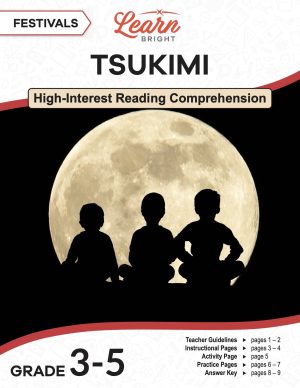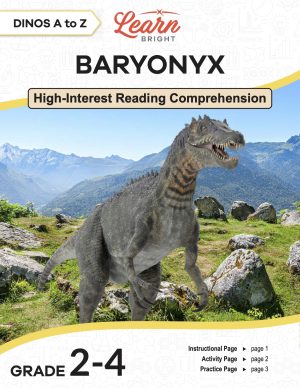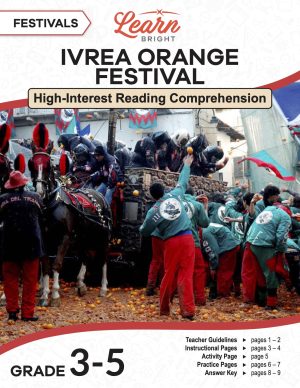Description
What our Metric Measurement (Grades 1-3) lesson plan includes
Our Metric Measurement lesson plan for grades 1-3 introduces students to the metric system and how it’s used. At the end of the lesson, students will be able to define metric measure and identify the units of measure within the metric system for length, volume, and weight. The students will also be able to distinguish between the different units of measure in the metric system. This lesson is for students in 1st grade, 2nd grade, and 3rd grade.
Classroom Procedure
Every lesson plan provides you with a classroom procedure page that outlines a step-by-step guide to follow. You do not have to follow the guide exactly. The guide helps you organize the lesson and details when to hand out worksheets. It also lists information in the blue box that you might find useful. You will find the lesson objectives, state standards, and number of class sessions the lesson should take to complete in this area. In addition, it describes the supplies you will need as well as what and how you need to prepare beforehand.
Options for Lesson
Included with this lesson is an “Options for Lesson” section that lists a number of suggestions for activities to add to the lesson or substitutions for the ones already in the lesson. One optional adjustment to the lesson activity is to increase the number of items. An optional addition is to have your students to practice using a ruler or meter stick to measure length using millimeters, centimeters, or meters. You could also display food packages or other items in your classroom that show the weight or amounts listed in both standard and metric measures. If available, you could demonstrate the use of a scale using grams or a measuring cup showing liters. Finally, to expand this lesson, you can discuss Fahrenheit versus Celsius with your students.
Teacher Notes
The teacher notes page includes a paragraph with additional guidelines and things to think about as you begin to plan your lesson. This page also includes lines that you can use to add your own notes as you’re preparing for this lesson.
METRIC MEASUREMENT (GRADES 1-3) LESSON PLAN CONTENT PAGES
The Basics of Measurement
The Metric Measurement (Grades 1-3) lesson plan includes two content pages. The lesson opens with a drawing of a line that’s about 7 inches. Did you know that there’s another way we can measure lines like that?
In the United States, we use the Standard System of measurement. The units of measurement for the Standard System include inches, feet, miles, ounces, pounds, cups, quarts, gallons, and more. Most people have heard of these units and use them to describe the length, weight, or volume of different things.
Other countries (and sometimes the United States!) use the Metric System, a decimal system of measurement based on meters, liters, and grams. For example, the 7-inch line from the beginning of the lesson is about 17 centimeters or 170 millimeters. The length of the line did not change, but the unit we used to measure it did.
We can use the Metric System to measure length (how long something is), weight (how heavy an object is), and volume (how much there is of something, usually a liquid), just like the Standard System.
Metric Measurement
The Metric System has three basic measurement units: meters, grams, and liters. This system uses prefixes to denote different sizes of length, width, and volume.
In the Standard System in the U.S., we use inches for short lengths and feet or miles for longer lengths. However, the Metric System uses millimeters for short lengths, centimeters and meters for middle lengths, and kilometers for longer lengths. Notice that the word meter is part of each of those words, and that the prefix changes. This is true for all of the Metric System units.
Length—Meter
Millimeters are used to measure very short lengths. We use millimeters to measure things like coin thickness; nail, bolt, or screw size; or insect length.
Centimeters are closest to inches. We use centimeters to measure things like pencil length, paper or shoe size, a TV screen, or a person’s height.
Meters are closest to feet or yards. We use meters to measure things like backyard size, pool length, track distance, or the length or width of a room.
Finally, kilometers are used to measure long distances. We can use them instead of miles to measure distance between towns, marathon races, or planet distance.
Weight—Gram
Milligrams are used to measures tiny weights. We use milligrams to measure things like the amount of sugar on a spoon, pill size, recipe ingredients, and more.
Grams are closest to pounds. We use grams to find the weight of things like people, packages, books, furniture, bikes, and more.
Kilograms are used to measure heavy weights. We use them instead of tons to weigh things like cars, trucks, dump truck loads, or the blue whale.
Volume—Liter
Milliliters are used to measure tiny amounts of liquid. We use milliliters to measure things like cough syrup, recipe ingredients, printer ink, or drops of water.
Liters are closest to gallons. We use liters to measure things like gasoline, milk, soda, orange juice, dog bowl, pot of water.
Kiloliters are used to measure large amounts of water. We use kiloliters to measure things like the amount of water in the ocean, a swimming pool, or lake.
The Metric System Units
The prefixes for each measurement are the same: milli-, centi-, and kilo-. Sometimes, you’ll see other prefixes like deca- and deci-, though they are much less common.
It’s important to understand the differences between metric measurement units. If someone asked you for a liter of water, you would want to make sure to give them the right amount. Would you rather eat a cookie that weighs half a gram or one milligram?
There are three main words you need to remember when using the Metric System: meter, gram, and liter. Combine them with the three prefixes (milli-, centi-, and kilo-), and you have a good understanding of the Metric System of measurement!
METRIC MEASUREMENT (GRADES 1-3) LESSON PLAN WORKSHEETS
The Metric Measurement (Grades 1-3) lesson plan includes three worksheets: an activity worksheet, a practice worksheet, and a homework assignment. You can refer to the guide on the classroom procedure page to determine when to hand out each worksheet.
WHICH MEASUREMENT ACTIVITY WORKSHEET
For the activity worksheet, students will look at different items, each of which is numbered. They will choose how each of the numbered items (or image of an item) would be measured using the Metric System of Measurement, circling the correct answers for length, weight, and volume.
METRIC MEASUREMENT PRACTICE WORKSHEET
The practice worksheet asks students to first answer a few multiple choice questions about the lesson material. They will also circle the metric measurement unit they would use for each object listed on the worksheet. Finally, they will write the metric units of measurement connecting the list of prefixes (centi-, milli-, and kilo-) with the list of bases (grams, liters, and meters).
DRAW A PICTURE HOMEWORK ASSIGNMENT
For the homework assignment, students will draw a picture or glue an image to represent each of the metric measurements listed on the worksheet. They will also answer a few questions about the lesson material.
Worksheet Answer Keys
This lesson plan includes an answer key for the practice worksheet. If you choose to administer the lesson pages to your students via PDF, you will need to save a new file that omits these pages. Otherwise, you can simply print out the applicable pages and keep these as reference for yourself when grading assignments.









